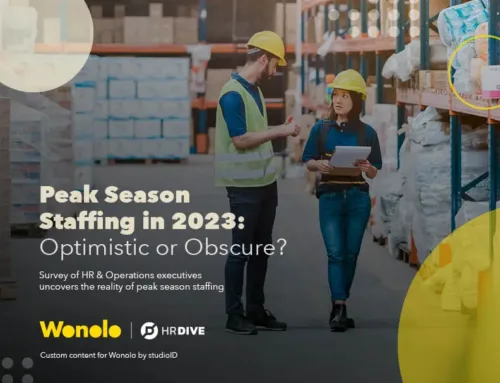Wonolo
Wouldn’t it be awesome to be able to hire seasonal workers without all the fuss and hassle of calling through lists of people, posting endless jobs, or vetting hundreds of workers?
We all know the answer to that question.
However, to achieve this goal, you must master the art of hiring seasonal employees.
Wait a second, you’re probably thinking, “I’ve hired hundreds of seasonal workers. I know what I’m doing – I’m the master of seasonal hires already.”
Just take a step back and think about it, though. Are you still doing the same thing every summer with the same level of success when it comes to hiring seasonal workers?
You wouldn’t settle for flat revenue year after year, so why are you settling when it comes to finding seasonal staff? These workers are the heart and soul of your company – don’t allow for second best.
So, how do you get started? Glad you asked. Follow these steps to find your seasonal worker staffing bliss.
P.S. Make sure you read to the end for a special Bonus Tip!
1. Plan, but plan differently when it comes to seasonal workers
It’s about time managers and owners left the dark ages of planning and joined the 21st century. Planning and project management are at the core of any good manager, but sometimes we just don’t have enough time to do it.
And, because of that, valuable seasonal workers often fall by the wayside when it comes to poor project management.
Luckily, there are now thousands (yes, thousands!) of easy-to-use tools that are designed to help you better wrangle this important task.
One of our favorites is Trello. Trello is a collaboration tool that organizes your projects into boards. At a glance, it tells you what’s being worked on, who’s working on what, and where something is in process.

We would suggest inviting the management team to your Trello board, and then they can assign individual tasks to different pools of workers, making your seasonal workers easier to manage and projects easier to track.
- Two other tools we find super helpful are:
- Nirvana
- TeamGantt
2. Actually communicate with your seasonal workers. You’ll be amazed.
Open communication in the workspace is arguably the most important factor in the success of a company. Even so, many companies don’t take the necessary steps to ensure this is the same for their seasonal employees.
Many of the world’s most successful companies are shaping their company and environment around communication, so why aren’t you?
Better communication doesn’t only create a better working environment, but it also creates a more innovative one.
If you think that seasonal employees can’t help drive innovation at your company, think again. Your seasonal workers could be your greatest asset when it comes to improving your workplace. Here’s why.
They don’t only work for you, but they also hold valuable knowledge about other successful companies that could not only improve your day-to-day operations but also help you uncover better solutions to bigger challenges your business might face.
As an added benefit, better communication can also lower turnover rates and increase employee engagement.

To get started with getting your seasonal workers better plugged in, set up a Slack channel – it’s a super simple way to message and collaborate between teams using your smartphone (It’s not just for tech startups!). And, set up a Google form to collect feedback from your seasonal workers.
3. Track performance not time
A seasonal workforce should be held to performance measures like any other part of your workforce. If anything, you should consider being more meticulous about the jobs they are carrying out because of how important they are to your company’s immediate success.
Recently, the Young Entrepreneur Council (YEC) asked its members to share ways in which each of their companies tracks and measures employee productivity, which we think hits the nail on the head.

As personal and professional lives continue to blend and work/life overlap becomes a reality, the only thing that counts is: Does the work get done? Contrary to popular belief, the only metric that really matters is task completion, not minutes spent working.
A great way to track productivity is by breaking down work into tasks and assigning them appropriately until projects are complete. We recommend doing this because it lets you focus on the bigger picture. A couple of great tools for this type of project management are Producteev and Basecamp.
iDoneThis is also a great piece of software to help you track the performance of your seasonal workers. It sends out a reminder email to each person at the end of the day. Individuals reply to it, and then everyone receives a compiled team digest the next morning. This allows transparency and accountability without micromanagement.
However, like most companies, you are going to need a way for your seasonal employees to clock in and out. We highly recommend using timesheet or timecard pro.
4. Hire awesome people faster
Tired of those time-consuming background checks?
We felt the exact same pain point. We onboard and background check thousands of seasonal workers every month, for companies all over the United States.
As a small startup, we’re sure you’re wondering, “How on earth do you background check that many people without a huge HR team?”
The answer lies with an amazing tool called Checkr. By performing background screening using their easy-to-use platform, we can screen candidates in just two and a half minutes on average.
Screening costs start at just $25 per person, and they even offer drug screening.
5. Cash is not always king
In 2013 alone, the Internal Revenue Service handed out $6.8 million in civil penalties for payroll errors, which added up to nearly $4.5 billion in fines. No one wants to deal with that!
If you decide that it makes sense to use an outside payroll service, be sure to spend adequate time investigating the right one for your type of business. Payroll services do way more than cut paychecks. Their basic services also include:
- Calculating employee pay, withholding, and taxes
- Printing and delivering checks
- Providing automatic signatures and direct deposit
- Employer tax payments and filing, as well as processing W-2 and 1099 forms
- Benefits administration for health insurance, flexible spending accounts, and retirement plans
- Allowing employees to edit their benefits information and contributions directly via the Internet
- Tracking paid time off, sick days, and overtime
- HR forms management
- Filing required reports with federal, state, and local governments
Imagine not having to spend days filing your tax returns, paperwork and working on your end-of-year compliance.
Our personal favorites in this space are Gusto and Intuit QuickBooks.
**Bonus Tip** Go on-demand!
You post a job, vet hundreds of workers, and whittle the list down to your favorite few seasonal workers, only to find half of them don’t turn up for their shifts. This doesn’t only hurt your productivity as a company, but it stops you from doing what you do best: being an awesome manager. Why? Because you have to spend the rest of your day calling through lists of people trying to get those shifts covered. Sound familiar?
If that’s the case, then on-demand staffing is about to become your new best friend. The stats don’t lie. Just like Uber did for cabs, the staffing world is being turned upside down by the on-demand model.
Instead of days, jobs are being filled in just minutes and companies are saving up to 45% vs. traditional staffing agencies. As many as 40% of Americans are now choosing to work contingent jobs because of the flexibility it offers, and in our opinion, some of the best are using on-demand services.
Companies from every industry imaginable are embracing the on-demand world and seeing some mind-blowing results not only for their seasonal workers but also for their bottom line.
You post a job, and a background-checked, vetted, and insured 1099 or W-2 worker picks up the job. Once the job is completed, you approve it. No paperwork, no fuss. Simple.
![]()


![[Report] Beyond the Gig: Exploring Reliable Work Options for the Modern Workforce](https://info.wonolo.com/wp-content/uploads/2023/10/Worker-Preferences-Report-Header-Image-500x383.png)



